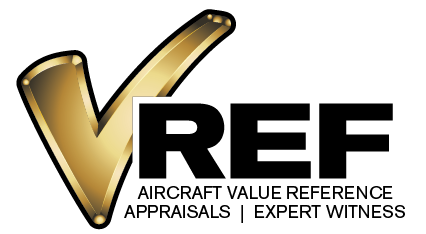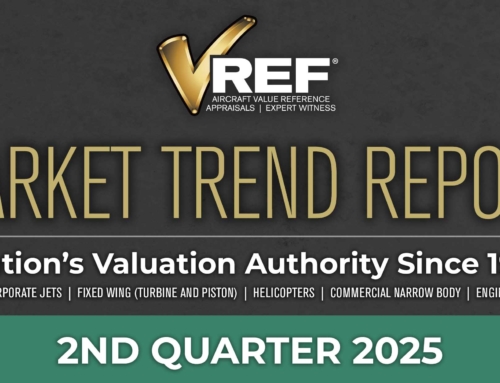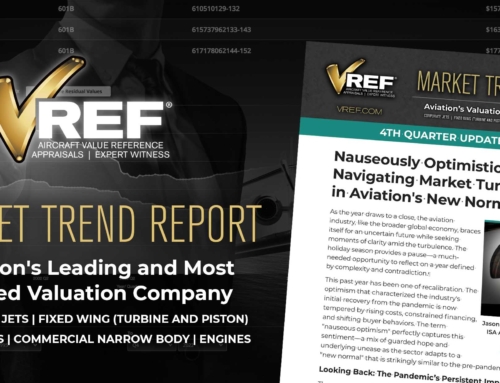VREF Value Vector Newsletter
3rdQuarter 2019
The summer is quickly coming to an end, and we are preparing for the rollout of our new VREF platform. By the time this newsletter has gone to print, many of you will have gotten a sneak peek, or even participated in our initial beta testing. What began a year ago as a complicated project is now heading into the completion of Phase 1. VREF’s new platform will be the benchmark for aircraft valuation.
The new platform features an intuitive user interface, which will allow users to move through the program by minimizing clicks. We even built in an advanced filtering system so no more searching for avionics or aircraft. Our avionics database has gone through a massive transformation as well, and we have three times as many parts and components as the previous platform. The new avionics database will provide users with substantially more data, and for the first time, you will know what lineage of avionics your aircraft has. Additionally, you’ll have the ability to manage your entire portfolio of aviation assets as we have implemented indexing for users. In the coming weeks, we will publish a special edition of the VREF Value Vector newsletter. It will not only provide a complete overview of the platform, but we will also go over the entire suite of features, and share with you how easy it will be to use.
Asset appraisals and the future of aviation were some of the key talking points when Our President Jason Zilberbrandwas the featured guest on Aviation Geeks Podcast. In case you missed it, you’ll want to check it out, so click HERE to have a listen.
VREF also attended the EAA Airventure in Oshkosh Wisconsin. Once again attendance was record-breaking, up almost 7% from 2018. Over 10,000 aircraft flew in, and there were nearly 40,000 campers in attendance. The manufacturers were all in attendance, and more importantly, everyone was busy, with several deals closing at the show. New orders reinforce our outlook on the experimental, light sport, and single-piston aircraft markets. These aircraft are in demand, backlogs are increasing, and the pre-owned inventory or lack thereof have demonstrated a trustworthy seller’s market.
As we head into the 4thquarter, we anticipate activity to increase substantially. Especially in the business jet market where 2020 compliance and aging aircraft have created uncertainty as to just how many airplanes are going to face the chopping block. We expect a large segment of the 20 and older biz jets to sit idle as experienced buyers step in after the deadline to cut deals and complete the compliance requirements. What could be seen as a negative for the industry might be a silver lining for numerous inventorying dealers looking to take on some projects.
As we look ahead, Risk Mitigation will be the theme of 2020. As traditional security threats persist and new cybersecurity vulnerabilities emerge, aircraft owners should be concerned. Risk is increasing by the use of new technologies leveraging 5G, ADS-B, CAN bus networks, and others. For the first time in modern aviation, operators will be forced to implement physical and cybersecurity protocols and processes to not only protect the passengers from malicious actors but the aircraft as well. VREF is not only aware and vocal on these issues, but we are doing something about it. VREF will be releasing the first-ever comprehensive security services that integrate cyber, physical, and infrastructure security services for aircraft owners, operators, and passengers who seek to protect themselves, their assets, and information from the increase in security threats. These services will be tailored to the client and scalable to the unique characteristics of the aircraft, airport, and support facilities in order to deliver practical security enhancements that protect against these persistent and emerging threats. VREF subscribers can learn more about these emerging security threats and vulnerabilities from blogs published on the VREF website.
Following the theme of Risk Mitigation, VREF is also proud to have Eric Puype as a member of our team to provide litigation consulting services specializing in aviation security. Eric is a security professional and attorney with over 22 years of experience in the industry and a decorated combat veteran who is referred to as an expert in this field by government and industry leaders. Learn more about Eric and his background here.
VREF has continued to add more aircraft to its database, and in the last quarter, we have added:
- Airtractor AT-602 and AT-802
- The Xtreme 41 and 42
- Saab 340 B & C
- Aerotek A240
- SeaMax M-22
- DeHavilland DHC-3-100, 200 and 300
- Dornier 228
- Ekolot Junior, Elf and Topaz
To those that communicate with us regularly, thank you! Your support and suggestions are always welcome. We do our very best to ensure we are adding aircraft you need data on to the database. We can assure you the new platform will not only be as easy (probably more comfortable) to use than the current version. We hope you will be blown away at the level of transparency, information, and features.
We look forward to seeing all of you at NBAA and without any further adieu here is the 3rd Quarter update.
Business Aviation:
Good news from Pilatus, Dassault, Embraer, Gulfstream, and Textron (Citation) as deliveries are up from the same period last year. Gulfstream also delivered its first G600 in August. Once you pull back the curtain, the overall activity levels are down from the same period the previous year. Continued talk about global economic issues and the looming recession, the stock market jitters are finally starting to show just how delicate business aircraft values are. Not surprising, Europe continues to lag behind the United States both in terms of utilization and activity levels. The summer slow down has undoubtedly not helped with the lack of transactions, but if nothing else, it is nice to see a normalized market establish itself again.
As stated several times in the last six months, we anticipate less activity through the balance of the year. This is due to in part to scrupulous buyers sitting out and waiting for procrastinating owners who might be faced with repossession or the scrapyard due to lack of 2020 compliance. Pre-owned inventory is climbing, and with fewer transactions, to absorb the aircraft combine for an impressive 4th quarter.
Turboprops:
The summer slow down is in full effect in the turboprop market, and a cool-down does not indicate any weakness. The average value is up across the board from the beginning of the year. King Air’s, Pilatus PC12’s, an Piper’s are still tending up. With less than 7% of the Total Fleet of these three manufacturers available on the pre-owned market, VREF is calling this a Seller’s market.
Helicopters:
Summer slow down or more bad news from the helicopter segment?
Deliveries were down by double digits across the board, with Robinson even feeling the pinch of deliveries being down 25% from the same period last year. Sometimes sales numbers can be misleading. The number of helicopter deliveries in the past several years has remained static; however, fewer more expensive large helicopters were sold, replaced with increased numbers of light helicopters. The price of oil is still a major debilitating factor in the vast helicopter world. Less than $60.00 per barrel oil will not support their use in servicing offshore oil platforms and exploration. The four largest operators of these large aircraft are restructuring under various legal options and hope to recover from their current financial situation and re-establish their presence. Of course, that will be difficult if the work they were previously doing does not return. For the bulk of us that could only dream of operating these large aircraft, the light helicopter market has seen slight growth with the usage being in the VIP, tourism, medical and emergency services and close-in offshore oil support sectors.
The medium helicopter market has seen the highest growth as they are popular with para-military/law enforcement and fire-fighting operations as well as in the construction and remote logistical support roles. The manufacturers have returned to producing multi-purpose helicopters in this size range allowing innovative operators to find work for them.
Piston:
Piston Markets show no slowdown unless you have been in a coma you are aware that 172’s, 182’s, as well as numerous trainers and Piper models have been skyrocketing in value. Cessna trainers are trending higher every week as fewer available aircraft ever hit the market. Diamond Aircraft is enjoying the market as its book dozens of orders in the past month as their aircraft continues to demonstrate popularity for flight schools. If EAA is any indicator of the coming months, the sales trends and appreciating values will continue for the near future. FLight schools and the lack of pilots are generating substantial demand for piston aircraft. Cirrus and Diamond values remain strong, and sales activities are impressive.
UAS:
The FAA approved the ver first BVLOS Drone FLight, why is this a big deal? Kansas Department of Transportation received permission to conduct the first-ever beyond-visual-line-of-sight (BVLOS) drone operation in the nation leveraging only onboard detect-and-avoid systems. KDOT is demonstrating the fantastic cost savings a UAS program can provide when it comes to infrastructure and rural missions. If you think about how much money it costs to man an aircraft to survey, for example, hundreds of miles of pipeline across Alaska, you can get an idea of how valuable BVLOS programs are.
The FAA also gave permission to a firm, that will start delivering food by Drone. SO if you live in Holly Springs, NC, you will want to keep an eye out (literally). The FAA Aerospace Forecast, Fiscal years 2019-2039 notes that small unmanned aircraft systems (sUAS) have experienced healthy growth over the last five years. The agency believes the sector will continue to expand. By 2023 the FAA predicts the non-model sUAS fleet will likely be three times larger than the current fleet, with the number of applications increasing as well.
- 21%: R&D Training/Education
- 21%: Film/Event/Entertainment/Sports
- 16%: Industrial/Utility/Environmental/Oil and Gas
- 13%: Real Estate4
- 8%: Construction
- 7%: Agriculture
- 6%: Other
- 5%: Press and Media
- 3%: Emergency and Preparedness
VREF will begin tracking and listing these various sUAS products in the new platform.
EUROPE:
As you may have noticed, VREF Appraisal Services and Litigation Consulting has expanded to Europe earlier this year. Our two offices (in Switzerland and Austria) offer aircraft appraisals and aviation consulting in the whole of Europe. They are headed by Dr. Andreas Grassl, ASA, our Senior Appraiser Europe, an aviation professional with more than 30 years of experience as an aviation attorney and more than 20 years as aircraft appraiser and claims adjuster. Andreas and his team of engineers, appraisers, and lawyers serve the whole industry, from single-engine trainers to airliners, from helicopters to simulators and ground equipment. So if you need an appraisal, technical expertise or maybe legal assistance, reach out to andreas@vref.com.
Europe witnessed a sizeable drop in small and mid-size business jet during the last quarter, in contrast, significant cabin departures were up, and long-range flights continued increasing market share. Also, many airlines reported growing passenger numbers and an increase in both offered seats and load factors.
The brokers we spoke to see a lot of opportunities and activity in the market, and AOC operators plan to grow their fleet, in particular in the large cabin and long-range segment.
On the manufacturer’s side, Diamond Aircraft is expanding its production site in Austria and is planning to create almost 200 new jobs by the end of 2019. So the demand in the light aircraft segment stays healthy too.
Form the regulatory side Europe has made a significant step forward in creating a level playing field for UAS manufacturers and operators: the European Commission adopted uniform technical requirements and consistent operational rules for all unmanned vehicles, i.e., both for professionals and those flying drones for leisure. There will be a certain transitional period, but the standards are set, and the industry can plan on a secure regulatory basis.





